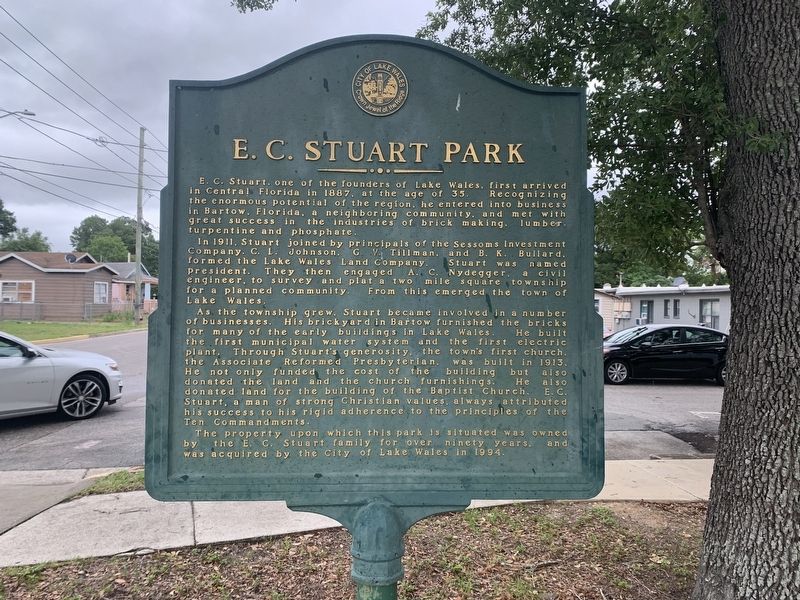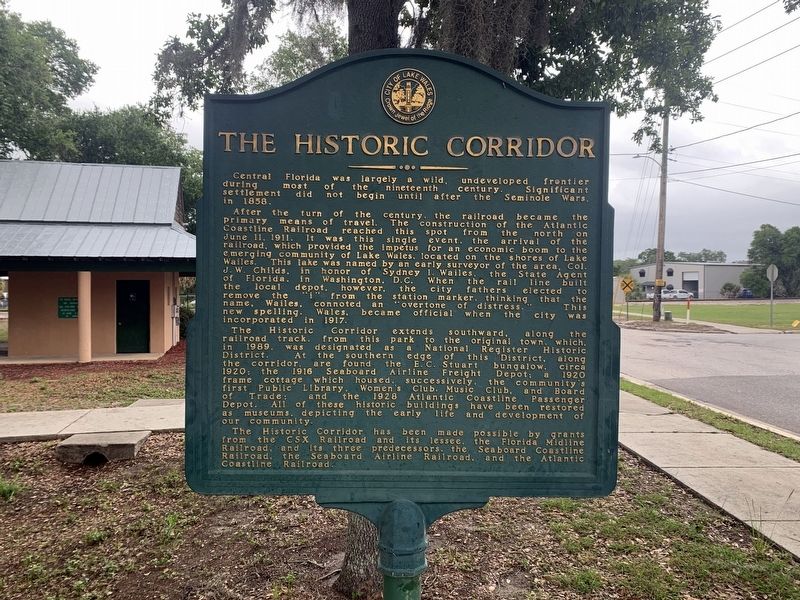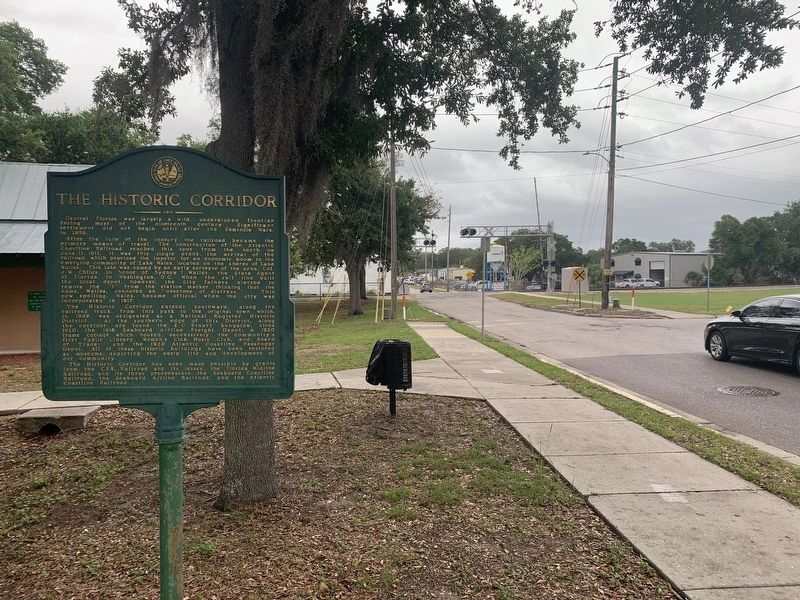Lake Wales in Polk County, Florida — The American South (South Atlantic)
E.C. Stuart Park / The Historic Corridor
E.C. Stuart Park
E.C. Stuart, one of the founders on Lake Wales, first arrived in Central Florida in 1887, at the age of 35. Recognizing the enormous potential of the region, he entered into business in Bartow, Florida, a neighboring community, and met with great success in the industries of brick making, lumber, turpentine and phosphate.
In 1911, Stuart joined by principals of the Sessoms Investment Company. C.I. Johnson, G.V. Tillman, and B. K. Bullard, formed the Lake Wales Land Company. Stuart was named president. They then engaged A.C. Nydegger, a civil engineer, to survey and plat a two mile square township for a planned community. From this emerged the town of Lake Wales.
As the township grew, Stuart became involved in a number of businesses. His brickyard in Bartow furnished the bricks for many of the early buildings in Lake Wales. He built the first municipal water system and the first electric plant. Through Stuart's generosity, the town's first church, the Associate Reformed Presbyterian, was built in 1913. He not only funded the cost of the building but also donated the land and the church furnishings. He also donated the land for the building of the Baptist Church. E.C. Stuart, a man of strong Christian values, always attributed his success to his rigid adherence to the principals of the Ten Commandments.
The property upon which this park is situated was owned by the E.C. Stuart family for over ninety years, and was acquired by the City of Lake Wales in 1994.
The Historic Corridor
Central Florida was largely a wild, undeveloped frontier during most of the nineteenth century. Significant settlement did not begin until after the Seminole Wars in 1858.
After the turn of the century, the railroad became the primary means of travel. The construction of the Atlantic Coastline Railroad reached this spot from the north on June 11, 1911. It was this single event, the arrival of the railroad, which provided the impetus for an economic boom to the emerging community of Lake Wales, located on the shores of Lake Wailes. This lake was named by an early surveyor of the area, Col. J.W. Childs, in honor of Sydney I. Wailes, the State Agent of Florida, in Washington, D.C. When the rail line built the local depot, however, the city fathers elected to remove the "I" from the station marker, thinking, that the name, Wailes, connoted an "overtone of distress." This new spelling, Wales, became official when the city was incorporated in 1917.
The Historic Corridor extends southward, along the railroad track, from this park to the original town, which, in 1989, was designated as a National Register Historic District. At the southern edge of this District, along the corridor, are found the E.C. Stuart bungalow, circa 1920; the 1916 Seaboard Airline Freight Depot; a 1920 frame cottage which housed, successively, the community's first Public Library, Women's Club, Music Club, and Board of Trade; and the 1928 Atlantic Coastline Passenger Depot. All of these historic buildings have been restored as museums, depicting the early life and development of our community.
The Historic Corridor has been made possible by grants from the CSX Railroad and its lessee, the Florida Midline Railroad, and its three predecessors, the Seaboard Coastline Railroad, the Seaboard Airline Railroad, and the Atlantic Coastline Railroad.
Erected by City of Lake Wales.
Topics. This historical marker is listed in these topic lists: Industry & Commerce • Parks & Recreational Areas • Railroads & Streetcars • Settlements & Settlers. A significant historical year for this entry is 1911.
Location. 27° 54.619′ N, 81° 35.424′ W. Marker is in Lake Wales, Florida, in Polk County. Marker is at the intersection of West North Avenue and A Street, on the right when traveling west on West North Avenue. Touch for map. Marker is in this post office area: Lake Wales FL 33853, United States of America. Touch for directions.
Other nearby markers. At least 8 other markers are within 10 miles of this marker, measured as the crow flies. First Baptist Church (approx. ¾ mile away); Cannon from the USS Constitution
(approx. 0.9 miles away); Lake Wales Depot (approx. 0.9 miles away); Veterans Memorial (approx. 1.2 miles away); Church of the Holy Spirit (approx. 1.9 miles away); The Railroad in Dundee History (approx. 8 miles away); Surveyor's Lake Schoolhouse (approx. 9.3 miles away); Chief Chipco (approx. 9.7 miles away). Touch for a list and map of all markers in Lake Wales.
Also see . . . Stuart Park. (Submitted on June 16, 2022, by Tim Fillmon of Webster, Florida.)
Credits. This page was last revised on June 16, 2022. It was originally submitted on June 15, 2022, by Tim Fillmon of Webster, Florida. This page has been viewed 615 times since then and 23 times this year. Photos: 1, 2, 3. submitted on June 16, 2022, by Tim Fillmon of Webster, Florida.


